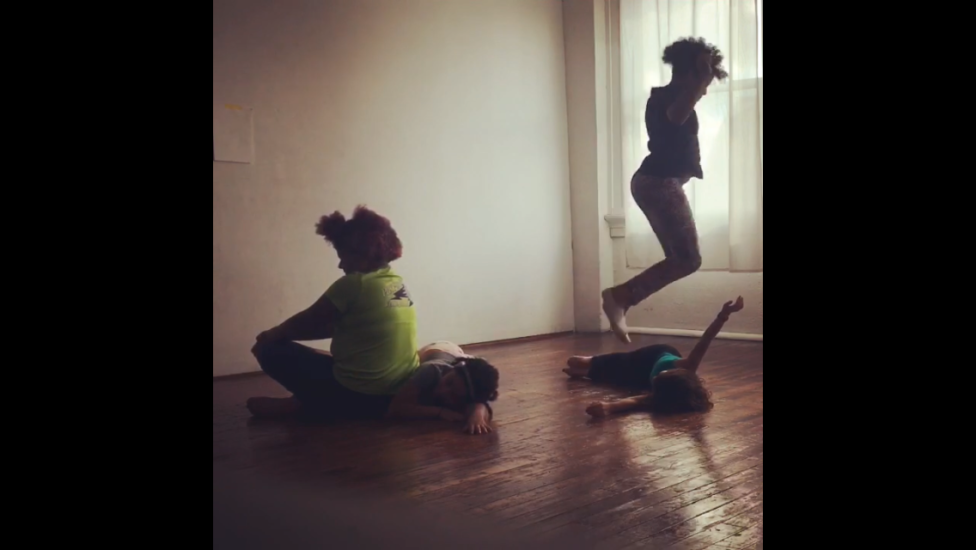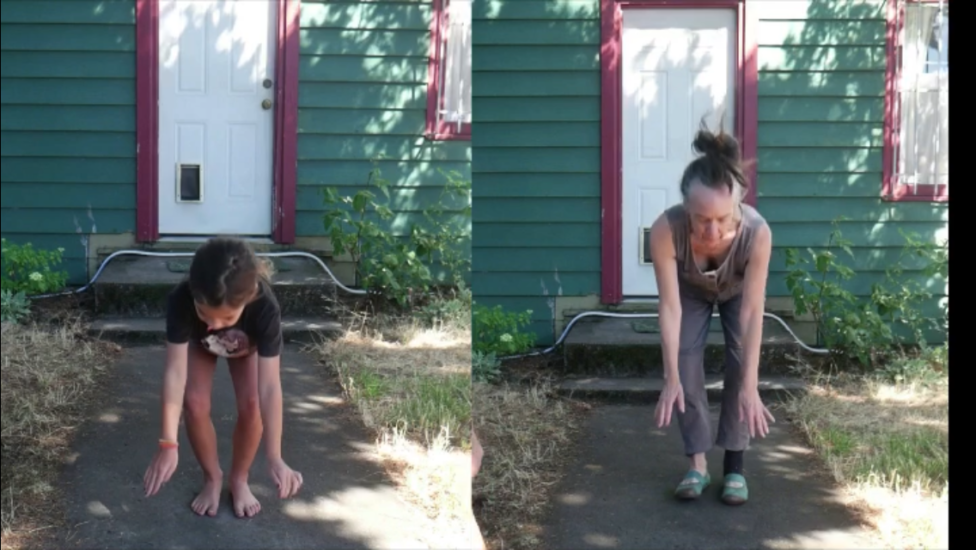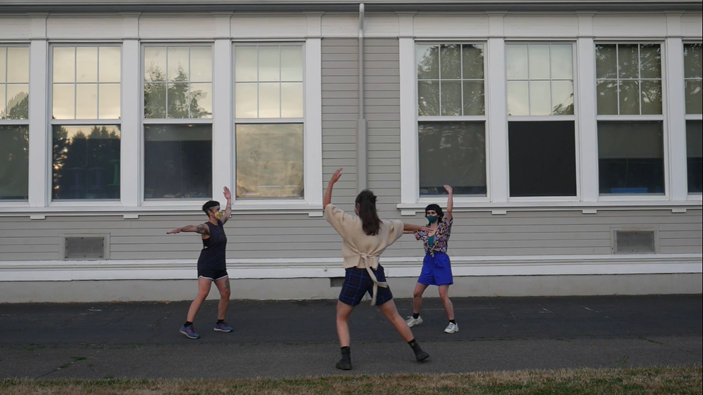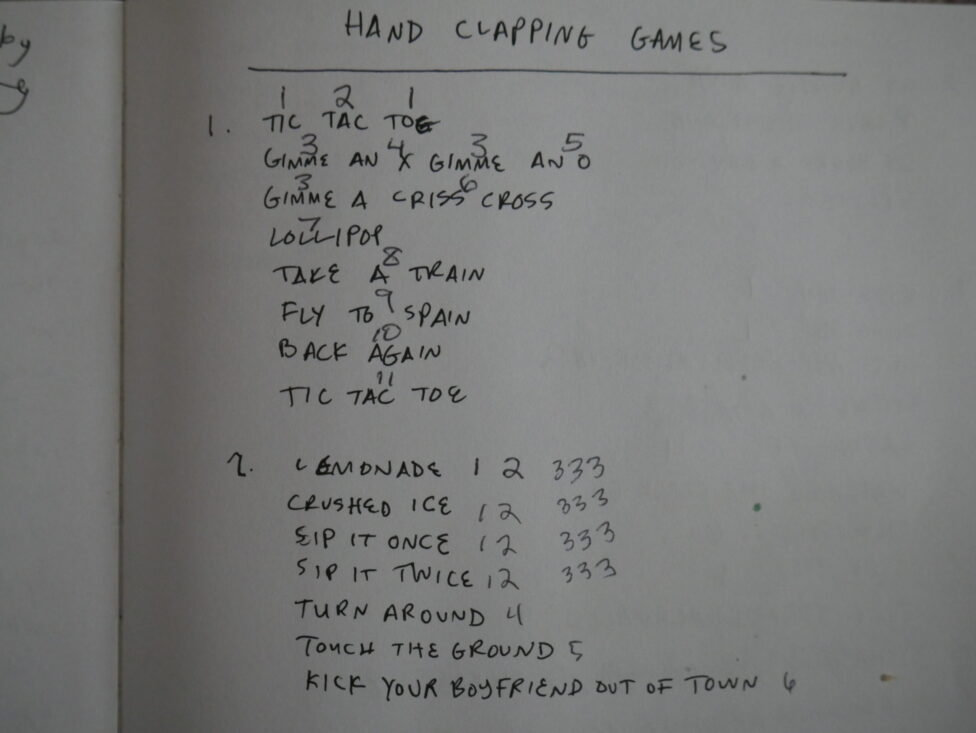Hannah Krafcik: claire, if you wouldn’t mind just sharing the name of the work that you’re making and a little summary of it.
claire barrera: The work is untitled as of now but I have been thinking about the name, tu eres mi otro yo, using it as a working title even though I don’t plan on it being the final title. But the piece has been in progress for a little over a year now and the seeds of the piece were me thinking about children’s games in particular. I was originally thinking about clapping games and the way that games and play offer opportunities to act out social relations and social patterns—both reenacting ways that they already exist but also having a space to play around with new ways of being together in groups of people. And also maybe on the flip side, playing with ways that we can be together in ways that maybe can harm each other or can help us grow as a community. That’s a very short version of the beginning of this piece. In its current form, it involves three young people and three adults. I think very early in the process, I imagined it being multi-age for a number of reasons.
HK: I’ve spent a lot of time thinking about this piece in preparation for our conversation and the working description where we’re thinking about practicing social relation and the harm that may emerge out of it, but also the radically new or different social relation that can emerge through play. My brain first goes to this aspect of harm, but just hearing you talk about play as a space to imagine new social relations, I’m feeling connected to that childhood experience of having not been fully programmed and being able to have a relationship to people—a literal new relationship to people almost, where things are more fresh.
cb: A question for me from before this piece began that I’ve been grappling with for a while is how do we make things different? How do we get from where we are now to somewhere different or better? And for my last work, Sugar, I was looking at times and history where people have tried something really new and really different. And for me, when I allow myself to be in a playful space as an artist, those are moments when new things can emerge either just in the creative process, or a lot of it was also about trying to change personal patterns in order to heal trauma. There’s a leap that happens where I don’t know how to do this and the only way I can figure out how to do this is to go into an unknown space. But I need that space to be playful and I need to hold some degree of curiosity and non-judgment if I’m trying to create a new pattern.
Those questions continued for me after I finished my solo piece Sugar. As somebody who spends a lot of time with kids and also has my own child, I’ve been observing more thoughtfully and consciously how important play is to social movements, to healing, to creativity, and how play could be a really important thing when we’re asking ourselves, how do we create something new in the world? Kids are doing that all the time because everything is new to them. Nothing is set in stone. I mean things begin to get more set in stone from day one, but less so I would say, and practice is happening for them all the time. They don’t assume they already know because they’re being told all the time by the world that they don’t know. Young people have more acceptance for not knowing. And you can really see that coming through in kids games, which is something that I’ve observed over my years. I can keep talking about that forever.

Photo courtesy of the artist.
ID: Four people, both adult and children, engage in physical activities together—jumping, sitting, and rolling on the wooden floor.
HK: Yeah absolutely!
I forgot to contextualize in the beginning that while claire is the creator of the work, I’m actually very fortunate to be a cast member in this work. I’ve been part of the process and in different relationship configurations to the other cast members as this process began, prior to the pandemic, and has really shifted throughout the course of the pandemic.
I am thinking about what you said about play as a space where you sort of have to go into with the intention of creating something new. That’s the way that you go about it and that I hold in my mind in relationship to these scores you’ve been offering us. I know a lot of those are sourced from children’s games that you’ve observed and played. Also, I just find myself always inspired by the way that you’re able to channel these games and create an iterative structure around them that still is able to hold the essence of the play that we’re seeking or working with. I don’t know if that brings anything up for you.
cb: I struggle all the time in the studio with coming up with ways to meaningfully take what I’m thinking about and then find different ways of approaching it in a creative process. One of the things that’s interesting about this piece is that it’s the first piece I’ve made where I had a sort of intellectual seed before. In the past, I’ve tended to work from a very intuitive place where I’m just in the studio fucking around, or I’m literally doing things that are just things I do to get by in life. Over time, the theme emerges and then I start building an intellectual or a more conscious structure around what’s happening. And that was a little different for this one. I had a more conscious inspiration earlier on in the process and then I had to build the intuition around it. Although I do feel like the conscious seed I had came from intuitive things—years and years of interests and noticing and stuff, I’m working kind of backwards with making the connections between the more conscious intellectual idea and what’s actually living in my body and what’s living in the collaborators’ bodies and what are things in daily life that I’m actually noticing? There’s been a lot of skill-building for me as I was working with you and the other collaborators, adults and kids, being able to stay really present in the rehearsals and then think back on those rehearsals and cultivate my ability to notice what was interesting in those rehearsals in relationship to the materials that we were working on. So it’s definitely stretched me in a lot of ways in ways that I really like and appreciate, to find ways into the material from the initial idea that I had.
One thing I’ll say is that it helps to be in relationship to the materials all the time, as somebody who is around kids all the time, and as somebody who does social justice work all the time. I can work on pausing and thinking about my week: what did I notice for that week or what was I playing with with kids that week or what were the difficulties that were coming up in organizing or social justice work that week that were interesting or challenging to me? Making work that’s about what you do all the time is so helpful.
HK: So it feels like a study of relationships, a reflecting back on the way that relationships work, and then how those relationships have been informed by past experience or not. We talked a little bit about this before, but do you know the age range of the cast members?
cb: Our youngest member is nine and then I can’t remember how old Linda is.
HK: I think 67?
cb: Mid to late 60s, yeah, that sounds right.
HK: So there’s the thing that we have been reflecting on where the younger members of the cast are in this moment where a lot of things are happening and getting integrated. They’re in development, like their identities, their physical abilities, their neurotypes. And then for some of the older members of the cast, we’ve been through that developmental stage and have been informed by life experiences and family and society. So there’s a little bit more retrospect there. Bringing it all together for me has felt a bit like time collapsing in on itself. As you’ve said, there is this opportunity to do this reflection and to ask questions about why things are the way they are within myself, if those things can change, and if I can still access that continued growth and development— the plasticity and the permeability within the boundaries of everything around me, questioning why those boundaries exist, whether they’re real, or whether something else might be possible.
cb: On the other hand, for the young people, what does it mean to have some discipline or to begin to be an editor to your experience, which is a really useful skill too. One thing I’m really looking forward to when we can all be together is to be able to mix up those skills a little more. What emerged for me in that video version that we showed at Performance Works Northwest in August was a little more of a divide that you’re describing where the kids are a little more spontaneous, more interactive. They’re getting to be playful in ways that the grown-ups were not because of their ages, but also because the adults aren’t able to touch each other due to social distancing, whereas I could be in-person with the youth.
One thing I’m looking forward to with the piece is to perhaps mix up who gets to perform the material; what is it like when the adults get to perform some of the sillier or more chaotic or unstructured things and what is it like when the kids maybe have to perform or work on some of the more structured or disciplined or edited moments? It’s reminding me of this game we used to play when I was a kid with my parents where we would pretend like we were putting my parents to bed and then as soon as we were leaving the room, our parents would be naughty. You know how much kids love to get to try on being the parents and the discipliner! I’m looking forward to maybe some of that role reversal getting to happen or just trying on each other’s hats and how that might bring new dynamics of this theme to the forefront.

Photo courtesy of the artist.
ID: Side by side frames of a child and an adult embodying similar physical positions in front of a house. Their knees bent, their heads tilted down, and their arms reaching towards the floor.
HK: Even in the very first rehearsal we had, I had a sense that that was happening in terms of approach. When you were talking about some of the adults getting to have a more playful unstructured experience, my thought process went to one particular cast member, and I was like, oh, I think that they know how to do that and would love to do that, for example. And then I thought about it more, how they’re such an experienced artist and have been making for such a long time. Perhaps, there is an air of discipline or structure that is infused even into play. Whereas with the games that you would play with your parents, there is an air of playfulness that is being imbued into the structure, the ritual, and the discipline of bedtime. And also just observing, as a childcare worker myself, the vast variety of ways in which young people choose to play and what their needs are for play, and how those evolve over time.
cb: It’s interesting that we’re talking about kids like they’re so spontaneous and playful, but kids can be some of the most self-editing creatures because of embarrassment. Or kids sometimes go through developmental phases where they have very black-and-white thinking about what’s acceptable and what’s not. I’ve noticed that sometimes they have very specific ideas of what dance means when they hear that word and so they produce a specific thing. So it takes skill as a director to help people access more variety or more curiosity.
Another thing that’s coming up as we’re talking is the dynamics—I’m hoping to have a variety of dynamics when we’re all together again—but there’s also the power dynamics between age, about consenting to doing different things in the rehearsal space. What does it mean to have this tiny body to be moving that can get hurt a lot more easily than yours, or maybe less easily depending on what we’re talking about.
HK: If it’s falling, definitely less. But getting smushed, may be not so good.
cb: The complexities of trusting someone to have power and agency, but also tending to the fact that there’s power dynamics with I’m an adult. I feel more comfortable speaking up sometimes than a young person does or I have different words than a young person does. And those all really relate to the themes that we’re working with.
HK: On an individual basis, there’s another variability within who feels comfortable speaking up in certain contexts and who doesn’t, who has words in certain situations and who doesn’t. I remember specifically in rehearsal one of the younger cast members speaking up a lot and stating their preference in ways that maybe I never would because that’s not my socialization, that’s not the upbringing that I had. It’s also not necessarily like in my nature to do that in a group context. And, yes, consent and boundaries, and considering the needs in the room.
It’s such a curious thing for me, as someone who’s worked with very young children in the past, this feeling of tension that I get when observing something playing out and being like, “This is making me uncomfortable, this is making me uncomfortable, should I intervene? Should I intervene?” But then the more that I hold back, most of the time young people just are able to work it out, to find solutions. And adults too, depending on the context. So that’s a sense that comes up for me in this process—letting the thing get worked out and seeing what emerges out of the thing that gets worked out. I remember we had a socially-distanced rehearsal at Woodstock Elementary outside, and we learned kind of a tough phrase. Then we sat and had a very generative talk about what it means to be in a game where maybe someone with a certain natural skill set would excel more than someone else and what it means to be out of or in a game.
cb: It goes back to what we’re talking about at the beginning: games and play have such capacity for fun and positive competition, teaching each other and trying new things together. They also have the capacity, depending on how they get used, to leave people out or punish people or maybe perpetuate some really yucky things. And we already bring histories with those things.
I remember that rehearsal, about how there’s all these echoes of what it means when you’re out of a game, like you failed in some way, but then we’ve also been playing with like, what if being out means you get to do all the fun stuff that doesn’t have rules or get to try something different. And what do we do to somebody who’s out? What if when somebody gets out, we all stop and do something really fun together? Can we reverse some of the usual things we do when somebody loses a game?
That’s one of the things that intrigued me about clapping games. They’re so iterative and they evolve a lot over time pretty organically. And that’s something important for me in social justice work too—what does it mean to embrace things not being right or wrong or perfect, but to try things out and then try and try again? And letting things evolve or grow or change.
HK: In talking about just trying things and seeing what works out, I can’t help but bring up the moment where so many things that are shifting right now. Just wondering if you’ve had the opportunity to think about how this is gonna affect our work together come next year.
cb: Can you explain to me what you mean by how “this” affects it? What do you mean by “this”?
HK: The pandemic and being distant and not really having a clear sense of what this work will look like or how it will take shape and how people will engage with it.
cb: Certainly for me as a body-based artist and the person who thought of this piece, I think the pandemic has really emphasized how critical being in in-person physical space is—for me as an individual person with my well-being, for me as an artist, and also for me as an organizer and activist. It is extremely difficult to organize only virtually. Virtual organizing, it can be an incredible tool. But for the way that I organize, it’s so much about embodiment and relationship and the people that I organize with. I am really struggling because we organize in a really heart-centered way that involves us feeding each other and touching each other and looking into each other’s eyes.
For this piece we found really creative ways to continue to work together during the pandemic through social distancing and through the virtual world. I don’t want to discount the creativity that’s come up with that, but I do feel like there’s a limit on exploring what I want to explore if we can’t actually be touching each other and looking at each other and breathing the same air. I think that’s true of children’s games, and you see it with the way kiddos are struggling with not getting to actually practice play in person. I think one aha moment I had did come from getting to do this virtually. When I was creating that work-in-progress for Performance Works Northwest, I decided that we would video some of our socially distant rehearsals and then edit those to present to people. That offered me a new tool for looking that I will use in the future.
As I was editing footage, I actually noticed that I wanted to focus on moments in the footage or in the sound score where there was laughter or people got irritated with each other or messed up and got frustrated with themselves, which all relate to what’s interesting to me about children’s games and play. So that was a moment that was useful to me about virtual work and I want to experience that in person. But where I’m at right now with it is to be really present with finding ways to still be together and continue to rehearse despite needing to socially distance or do it virtually and trust that something interesting will come of that and yet still I’m extremely committed to like all being together in person one day because the few rehearsals that we got to have before this started were so powerful getting to be kid and adult bodies together with different experiences in history was really powerful.

Photo courtesy of the artist.
ID: Three performers with their masks on rehearsing outside.
HK: I think so. Personally, even hearing you say that makes me a little emotional. That commitment to being together in person eventually, it feels really big, it feels really necessary, in every aspect of my life as an individual, I need that, I need to hold that close. So thank you for bringing that in.
cb: Thank you for ending that, it’s critical. I have no interest in staying, I can take lessons from this time, but I really look forward to going back to all being together.
HK: Absolutely, and we will.





